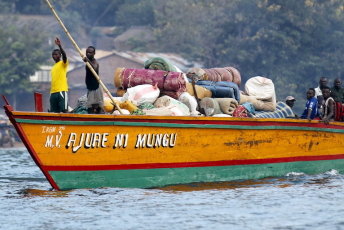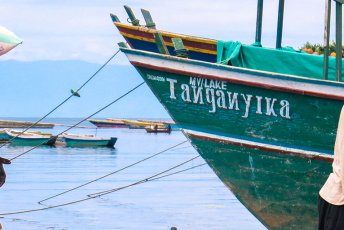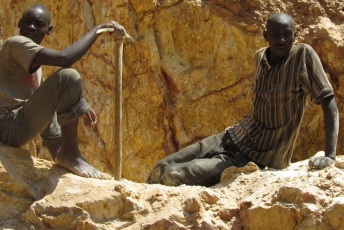Criminal entrepreneurs are tapping into Uganda’s vast reserves of sand, exploiting a sector which is largely unregulated by government. Posing as sand mining investors, they have formed local cartel networks with support from ‘influential people’ with government connections. They run and sell shipments of illegally mined sand from the country through an established regional and global black market.
Sand is a valuable non-renewable commodity used mainly for mega-infrastructure projects in the rapidly expanding African and global construction market. The transboundary industry undertakes mining in vast habitats including water bodies such as rivers, lakes and coastal areas as well as on land by digging sand pits.
The high-value and largely unregulated industry is estimated to account for 85% of all mineral exploration in the world. This translates to 50 billion metric tonnes of sand mined per year with a market value of US$99.5 billion in 2017. The value of the industry is projected to reach almost US$481 billion in 2100.
The cost of sand mining to the environment is steep. Unregulated extraction, especially around Uganda’s Lake Victoria, is destabilising the area’s sensitive ecology. There’s also evidence that it threatens local rural livelihoods, including both fishing and agriculture.
There are various methods for extracting sand, including digging it from pits in riverine ecologies and dredging it from swamps, wetlands and rivers that make up the Lake Victoria basin. Sand is mined from the rural districts of Masaka, Wakiso, Kalungu, Gomba and Mpigi around Lake Victoria.
Mining in these areas is informal and despite periodic condemnation by top state officials, including the president, government oversight is inadequate. This inaction has enabled the cartels to establish either irregularly licensed or unlicensed operations.
The mining is labour-intensive, employing men and youth, most of whom are underaged children. The men are largely used for digging out sand from pits. They work long hours, risking injury or even being buried alive in the dangerous quarries. Using wooden canoes, children dredge sand in the middle of fast-moving rivers without any protective gear.
Exploited with meagre daily wages, children do this risky work to pay school fees and contribute to their upkeep. Women are indirectly involved by selling food to workers and providing cleaning services such as washing lorries.
By tracing the movement of the sand, various crimes can be identified in the value chain. These include the mining , its transportation, the interlocutors involved, and selling the sand on the regional or global market.
The immediate market is in Uganda’s neighbouring countries of the Democratic Republic of the Congo, South Sudan and Rwanda, a sand transporter told ENACT on condition of anonymity. The sand is taken by road on tipper lorries. Once loaded onto a lorry, the transporter explained, it is already a sold product. This suggests that there’s a ready market in the receiving countries.
Sand prices differ by type, but river sand is the most trafficked as it is preferred in the construction industry. Depending on quality, it costs between USh200 000 (USD55) and USh800 000 (USD215) per lorry. It is impossible to distinguish between legally or illegally mined sand, and smugglers forge exportation licences to ferry the sand through border (points.
The transporter told ENACT that while moving the sand, the networks collude with customs and law enforcement officers to avoid paying the tax of USh80 000 (USD22) per lorry. They instead pay police between USh50 000 (USD14) and USh100 000 (USD27) to allow lorries through.
This sand is also shipped to China, one of Uganda’s top trading partners. A Chinese firm licensed to make only ships was found engaging in sand mining from Lake Victoria. Attempts by Uganda’s National Environment Management Authority to stop the ongoing excavations in 2018 failed. Local government officials supported by the president’s brother were seen siding with the Chinese firm.
Data on Uganda’s sand exports is not reliable. For example in 2015 the country exported 22 tonnes, earning USh253 million (USD68 500), but exported 19 tonnes in 2016, earning only USh16m (USD4 300). Information is also lacking on registered sand miners in Uganda, as well as the regional or global sand companies that trade with the country.
The lack of accurate export data shows the difficulty of tracking illicit flows that often take place on the black market. Mining of Uganda’s other minerals such as limestone and gold also face severe revenue leakages and criminality due to lack of formalisation, investment and adequate government oversight.
With rapid urbanisation and infrastructure development, the UN Environment Programme forecasts a 5.5% rise per year in sand demand. The informality in Uganda’s sand mining sector however denies the government potential revenue. And despite national and local government being aware of the problem, common approaches to solving it are lacking. Regulating the industry is also complex, as shown by the lack of coordinated government responses.
Gaps in the Uganda’s laws also limit the country’s ability to regulate sand mining. The new mining and minerals policy passed in 2018 gives only a basic legal framework. It doesn’t define small-scale artisanal sand miners who have often decried unclear licensing and regulating processes that target them rather than large-scale sand miners.
The policy also directs only the environmental authority and local government to regulate and enforce the measures. Uganda’s local administrations are underfunded and even when they periodically ban sand mining, they lack the resources and political will to enforce the bans. These inefficiencies encourage officials to collude with local sand cartels.
Sand as a unique natural resource should not be collectively governed only by the mining and minerals policy. There is need of having a policy in place to govern sand mining. The policy should regulate the activity and commerce of sand mining, and also protect water and land bodies where sand in mined.
To improve sand mining governance, Uganda needs to fill the legal gaps and put in place a market system with appropriate regulations. This could include gazetting mining areas and registering miners to avoid clientelism in issuing licences. Curbing the informality of the practice is also vital. This would not only stop the criminality in the value chains, but generate revenue that could help build the national and local capacity to protect Uganda’s minerals and natural environment.
Mohamed Daghar, Researcher, ENACT project, ISS







